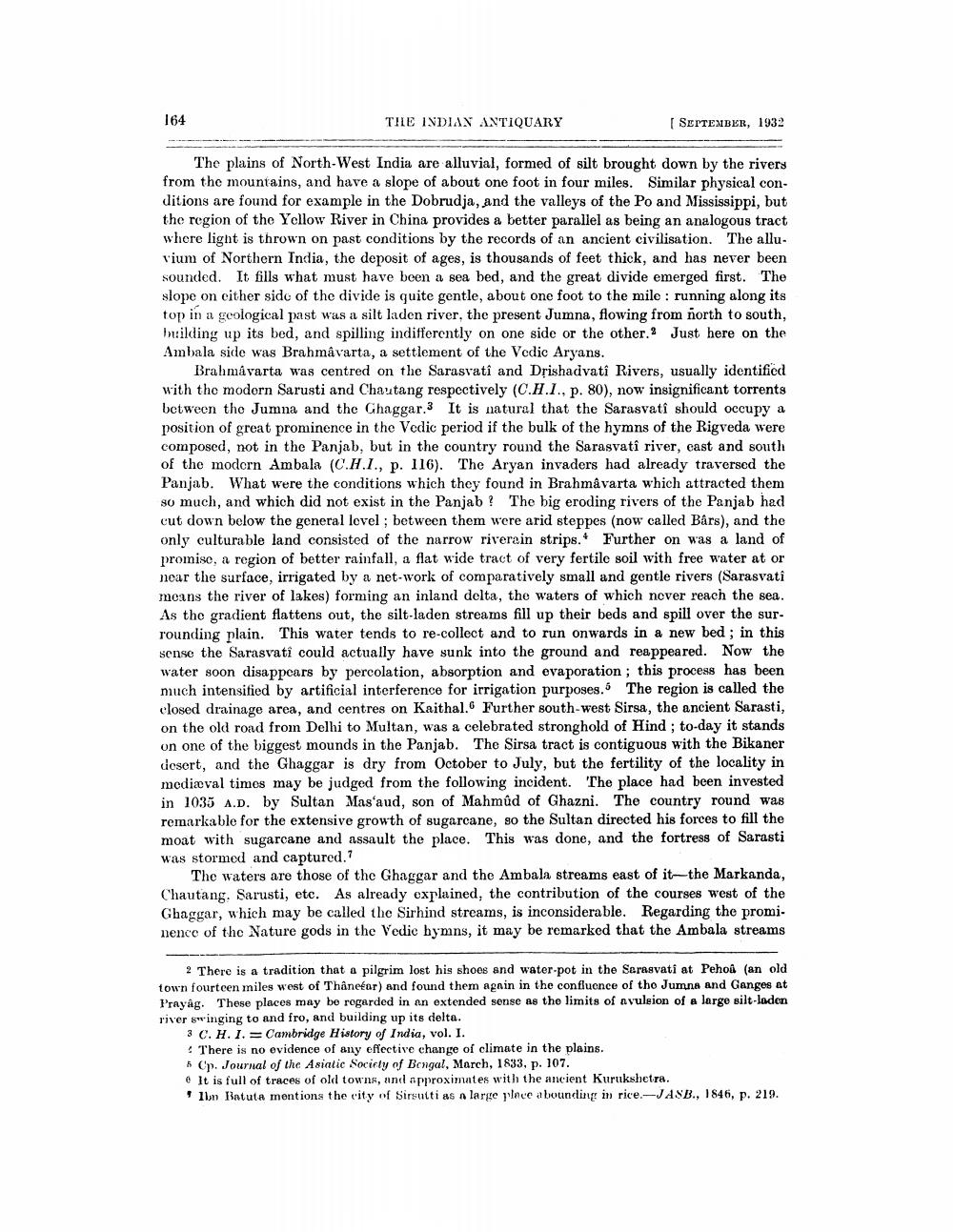________________
164
THE INDIAN ANTIQUARY
SEPTEMBER, 1932
The plains of North-West India are alluvial, formed of silt brought down by the rivers from the mountains, and have a slope of about one foot in four miles. Similar physical conditions are found for example in the Dobrudja, and the valleys of the Po and Mississippi, but the region of the Yellow River in China provides a better parallel as being an analogous tract where light is thrown on past conditions by the records of an ancient civilisation. The alluvium of Northern India, the deposit of ages, is thousands of feet thick, and has never been sounded. It fills what must have been a sea bed, and the great divide emerged first. The slope on either side of the divide is quite gentle, about one foot to the mile : running along its top in a geological past was a silt laden river, the present Jumna, flowing from north to south, building up its bed, and spilling indifferently on one side or the other. Just here on the Ambala side was Brahmavarta, a settlement of the Vedic Aryans.
Brahmavarta was centred on the Sarasvati and Drishadvati Rivers, usually identified with the modern Sarusti and Chautang respectively (C.H.I., p. 80), now insignificant torrents between the Jumna and the Ghaggar.3 It is natural that the Sarasvati should occupy a position of great prominence in the Vedic period if the bulk of the hymns of the Rigveda were composed, not in the Panjab, but in the country round the Sarasvatî river, cast and south of the modern Ambala (C.H.I., p. 116). The Aryan invaders had already traversed the Panjab. What were the conditions which they found in Brahmåvarta which attracted them so much, and which did not exist in the Panjab ? The big eroding rivers of the Panjab had cut down below the general level ; between them were arid steppes (now called Bars), and the only cultura ble land consisted of the narrow riverain strips. Further on was a land of promise, a region of better rainfall, a flat wide tract of very fertile soil with free water at or near the surface, irrigated by a net-work of comparatively small and gentle rivers (Sarasvati means the river of lakes) forming an inland delta, the waters of which never reach the sea. As the gradient flattens out, the silt-laden streams fill up their beds and spill over the surrounding plain. This water tends to re-collect and to run onwards in a new bed; in this sense the Sarasvati could actually have sunk into the ground and reappeared. Now the water soon disappears by percolation, absorption and evaporation; this process has been much intensified by artificial interference for irrigation purposes. The region is called the closed drainage area, and centres on Kaithal. Further south-west Sirsa, the ancient Sarasti, on the old road from Delhi to Multan, was a celebrated stronghold of Hind; to-day it stands on one of the biggest mounds in the Panjab. The Sirsa tract is contiguous with the Bikaner desert, and the Ghaggar is dry from October to July, but the fertility of the locality in mediæval times may be judged from the following incident. The place had been invested in 1035 A.D. by Sultan Mas'aud, son of Mahmûd of Ghazni. The country round was remarkable for the extensive growth of sugarcane, so the Sultan directed his forces to fill the moat with sugarcane and assault the place. This was done, and the fortress of Sarasti was stormed and captured.?
The waters are those of the Ghaggar and the Ambala streams east of it--the Markanda, Chautang. Sarusti, etc. As already explained, the contribution of the courses west of the Ghaggar, which may be called the Sirhind streams, is inconsiderable. Regarding the promi. nence of the Nature gods in the Vedic hymns, it may be remarked that the Ambala streams
2 There is a tradition that a pilgrim lost his shoes and water-pot in the Sarasvati at Pehoa (an old town fourteen miles west of Thânear) and found them agnin in the confluence of tho Jumns and Ganges at Prayag. These places may be rogarded in an extended sense as the limits of a vuleion of a large silt-laden river swinging to and fro, and building up its delta.
3 C.H.I.= Cambridge History of India, vol. I.
There is no evidence of any effective change of climate in the plains. 5 Cp. Journal of the Asiatic Society of Bengal, March, 1833, p. 107. 0 It is full of traces of old towns, and approximates with the ancient Kurukshetra. # Ibn Batuta mentions the city of Sirsutti as large place abounding in rice.-JASB., 1846, p. 219.




